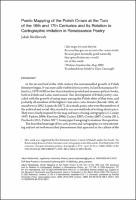Chapter Poetic Mapping of the Polish Crown at the Turn of the 16th and 17th Centuries and Its Relation to Cartographic Imitation in Renaissance Poetry
| dc.contributor.author | Niedzwiedz, Jakub | |
| dc.date.accessioned | 2022-06-01T12:14:41Z | |
| dc.date.available | 2022-06-01T12:14:41Z | |
| dc.date.issued | 2020 | |
| dc.identifier | ONIX_20220601_9788855181983_319 | |
| dc.identifier.issn | 2612-7679 | |
| dc.identifier.uri | https://library.oapen.org/handle/20.500.12657/56136 | |
| dc.description.abstract | The paper is devoted to the problem of imitation of maps in the late Renaissance Polish poetry (between 1580 and 1630). The author first discusses the special interest in cartography that existed among the Polish elite and poets of the period. The main thesis of the paper is that poets widely used map-based techniques in constructing their poems. Imitation (imitatio) played a crucial role in this process. To illustrate this concept, the author analyses the work of five poets: S.F. Klonowic, K. Miaskowski, S. Petrycy, M.K. Sarbiewski and Sz. Szymonowic. Looking at the shared topoi used in poems and maps and investigating how the late Renaissance poets described the territory of the Polish-Lithuanian Commonwealth, allows the author to draw a similarity between controlling space in poetry and maps. This suggests the idea of ruling over space might be related to the 16th-century idea of a God-like poet. | |
| dc.language | English | |
| dc.relation.ispartofseries | Biblioteca di Studi Slavistici | |
| dc.subject.other | Renaissance Polish poetry | |
| dc.subject.other | cartography | |
| dc.subject.other | maps | |
| dc.subject.other | imitation | |
| dc.subject.other | mimesis | |
| dc.title | Chapter Poetic Mapping of the Polish Crown at the Turn of the 16th and 17th Centuries and Its Relation to Cartographic Imitation in Renaissance Poetry | |
| dc.type | chapter | |
| oapen.identifier.doi | 10.36253/978-88-5518-198-3.07 | |
| oapen.relation.isPublishedBy | bf65d21a-78e5-4ba2-983a-dbfa90962870 | |
| oapen.relation.isbn | 9788855181983 | |
| oapen.series.number | 45 | |
| oapen.pages | 20 | |
| oapen.place.publication | Florence |

